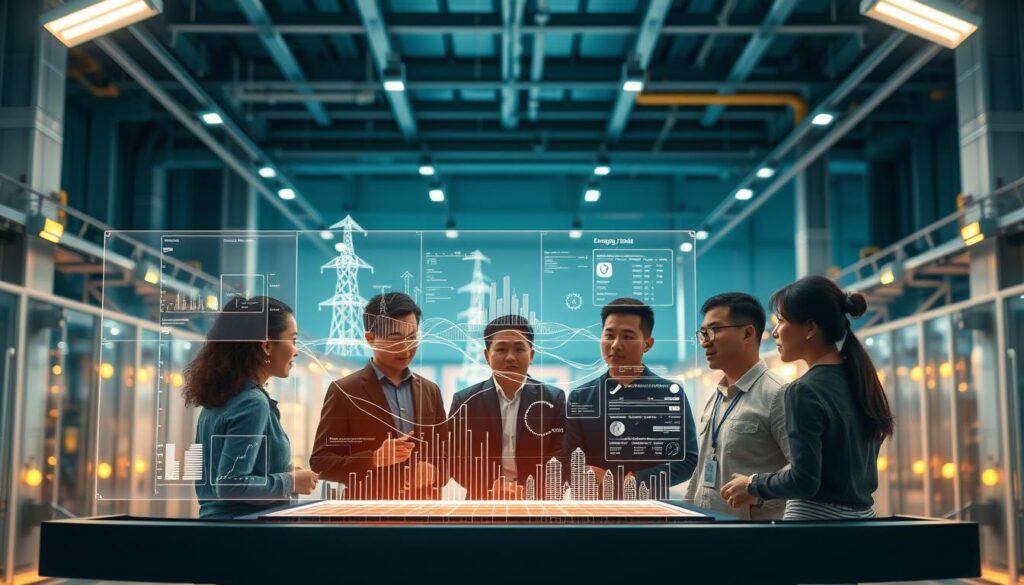The world needs sustainable energy solutions now more than ever. Can AI really change how we use energy, or is it just a trend? AI is changing the energy sector for the better. It helps make energy use more efficient and sustainable.
Studies show AI can help in many ways but also has some downsides. We must use AI wisely for a sustainable future. This is true, even more so in places like Southeast Asia.
Using AI can make energy systems more reliable and cheaper to run. It helps use more renewable energy. But, managing all the data AI creates is a big challenge.
We need to make sure the data is good quality. This will help AI work better. Let’s look at how AI can change the energy world for the better, the challenges it brings, and how we can overcome them.
Key Takeaways
- AI is redefining energy efficiency and operational reliability in the industry.
- Advanced predictive analytics enhance management practices in energy consumption.
- AI contributes significantly to achieving the Sustainable Development Goals (SDGs).
- Understanding the ethical implications of AI deployment is critical for sustainable practices.
- Partnerships between energy and AI sectors can optimize sustainability efforts.
How AI is Transforming the Energy Sector
AI is changing the energy sector in big ways. It makes things more efficient and cuts costs. Companies use AI to work better and meet market needs. This leads to better use of resources and more sustainability.
Enhancing Efficiency through Predictive Analytics
Predictive analytics with AI helps guess energy demand. This helps plan better, avoiding blackouts. It’s a big step towards balancing supply and demand.
Real-time Monitoring and Management
AI watches energy use in real time. It helps fix problems fast. It also cuts down on waste, making homes more comfortable. These smart solutions are key to better energy use.
Case Study: Singapore’s Smart Grid Initiatives
Singapore is leading with its smart grid projects. They use AI to mix renewable energy safely. This shows AI’s power in making energy systems better. Learn more about this change here.

AI Innovations for Renewable Energy
Artificial Intelligence is changing the renewable energy world. It boosts efficiency and improves forecasting. AI tools are key for better solar and wind energy. These tools help increase productivity and support sustainability goals.
AI in Solar Energy Optimization
AI can make solar energy up to 20% more efficient. It uses weather data and production history to optimize energy. With solar investments set to hit ₱28.5 trillion in 2024, AI is crucial for success.
Wind Energy Forecasting with AI
AI makes wind energy forecasting better. It helps predict energy output accurately. This leads to better planning and less use of fossil fuels.
Example: China’s Wind Power Projects
China is using AI in its wind power projects. It aims to boost efficiency and cut risks. This could reduce downtime by up to 70%.

| AI Application | Impact on Renewable Energy | Efficiency Improvement |
|---|---|---|
| Solar Energy Optimization | Increases energy generation and reduces costs | 20% |
| Wind Energy Forecasting | Enhances accuracy of energy production predictions | Varies (improves operational reliability) |
| Predictive Maintenance | Extends lifespan of equipment and reduces downtime | Up to 70% reduction in downtime |
The Impact of AI on Energy Consumption
AI has a big impact on how we use energy, thanks to smart grids and demand response. Smart grids use AI to track energy use in real time. This helps utilities manage energy better during busy times.
This approach means we don’t need as much infrastructure. It also helps avoid power outages. As AI in energy gets better, we can use resources more wisely. This makes energy use more sustainable.
Smart Grids and Demand Response
Smart grids change how we get and use electricity. They use AI to balance energy supply and demand. This way, utilities can adjust energy distribution based on what people need.
This smart management cuts down on energy waste. It also makes the system more reliable. It’s a big step towards a better energy future.
Reducing Waste with AI Analytics
AI analytics help find where energy is wasted. Companies use these tools to find and fix inefficiencies. For example, AI in smart homes can cut CO₂ emissions by up to 40%.
This helps us use energy in a way that’s better for the planet. It’s a big step towards meeting our sustainability goals.
| AI Tool | Application | Impact on Energy Consumption |
|---|---|---|
| Smart Grid Systems | Real-time monitoring | Minimizes peak demand and reduces blackouts |
| Demand Response Programs | Consumer energy management | Encourages energy-saving behaviors |
| AI Analytics | Identifying inefficiencies | Optimizes resource allocation and reduces waste |

AI Tools Driving Sustainability Efforts
Artificial intelligence is key in making the energy sector more sustainable. It helps companies make better choices that are good for the planet and improve how they work. AI is great at managing energy and automating energy tasks. These help the industry perform better and be more eco-friendly.
Energy Management Systems and AI
AI-powered energy management systems can manage energy use in real-time and predict needs. This makes energy use more efficient and cuts costs and harm to the environment. AI also helps plan better use of renewable energy, making grids work better.
Automation in Energy Operations
AI makes energy operations smoother by automating tasks. It keeps energy flowing by predicting when things might go wrong. This means less downtime and a steady supply of energy. For example, Tesla’s AI systems help manage energy use during busy times, saving money and improving performance.
| AI Applications | Benefits | Environmental Impact |
|---|---|---|
| Energy Management Systems | Optimizes energy consumption and reduces operational costs | Minimizes greenhouse gas emissions |
| Predictive Maintenance | Extends lifespan of equipment | Prevents disruptions in energy supply |
| Automation in Operations | Improves reliability and reduces human error | Decreases carbon footprint |
| Real-time Monitoring | Enhances system effectiveness with immediate responses | Supports sustainable energy generation |

Collaborations Between AI and Energy Companies
Working together in the energy sector is key to using AI for renewable energy. In places like ASEAN, AI companies and energy firms are teaming up. This is leading to big steps forward in technology.
These partnerships help create new ways to use energy better. They also make sustainability and managing resources more effective.
Partnerships in the ASEAN Region
In the ASEAN area, AI is making energy management better. Companies are sharing their knowledge and tools. This helps create AI that saves energy and boosts efficiency.
By using AI for sustainability, these partnerships help cut down on carbon emissions. They also support the use of clean energy.
Case Study: Collaboration Between Japan and the Philippines
A great example is the partnership between Japanese and Philippine energy companies. They’re working together to use AI for better energy management. Their goal is to make energy supplies more reliable and green.
This project shows how important it is for regions to work together. It helps tackle energy challenges and adopt eco-friendly technologies.
AI for Enhancing Energy Storage Solutions
Energy storage is key to modernizing the energy sector. Using AI in energy storage systems makes them more efficient and reliable. AI helps manage batteries better, improving safety and lifespan.
This new approach lets us store energy from renewable sources efficiently. It also makes sure we can use it when we need it most.
Next-Generation Battery Management Systems
Next-generation battery systems use AI to boost storage. AI helps these systems watch battery performance in real time. It can even predict when a battery might fail.
This early warning lets us fix issues before they cause problems. It helps batteries last longer, saving money and protecting the environment.
AI in Grid Storage Optimization
AI is crucial for better grid storage. It improves forecasting and managing energy demand. AI analyzes data from renewable sources, like wind turbines.
This helps adjust energy distribution in real time. It ensures we use resources wisely and cut down on traditional energy needs.
Policy and Regulation: AI in Energy
Regulatory frameworks are key to AI’s success in the energy sector. Governments are stepping up to support AI for sustainability. They aim to integrate AI ethically and advance energy systems.
These frameworks need to keep up with AI’s fast development. They must ensure compliance and encourage innovation. Policies will also focus on AI’s environmental impact, aligning with sustainability goals.
Government Initiatives Supporting AI Adoption
Many governments have set guidelines and initiatives for AI in energy. AI is making energy systems more efficient and reliable, like in smart grid management. Here are some key efforts:
- Investment in smart meters that provide real-time data to consumers and energy providers.
- Development of machine learning models to better forecast energy demand and optimize resource allocation.
- Promotion of public-private partnerships to facilitate the integration of energy sector AI innovations.
Adapting Regulations for Emerging Tech
As AI evolves, regulations must keep up. This ensures energy systems stay stable and efficient. Key areas include:
- Establishing robust data collection protocols to ensure consistency across AI applications.
- Implementing ethical guidelines that address concerns about job displacement and bias in AI decision-making.
- Adapting regulatory frameworks to incorporate sustainability objectives, promoting a reduction in overall carbon footprints.
AI in the energy sector brings both challenges and opportunities. Governments must balance innovation with environmental protection. This approach will help the energy sector fully benefit from AI.
Future Trends of AI in Energy and Sustainability
The future of AI in energy and sustainability looks bright. AI will help us deal with climate change better. It will help us find new ways to manage energy and use renewable sources.
The Role of AI in Climate Resilience
AI is key in fighting climate change. It helps us predict energy needs and manage it better. This makes our energy systems more efficient and reliable.
AI also helps keep our energy systems running smoothly. It predicts when parts might break, so we can fix them before they do. This keeps our energy flowing without interruptions.
Emerging Technologies to Watch
New technologies are on the horizon. AI will make predicting energy from renewables more accurate. This will help us use different energy sources better.
Energy storage, like Tesla’s Powerwall, is getting smarter. AI helps these batteries last longer and charge more often. This is good for the planet and shows we need to keep innovating.
AI will keep getting better at managing energy. It will make predicting energy needs even more precise. This means we’ll need less backup energy.
We’ll see more partnerships between energy companies and AI tech firms. This will help us use AI in our daily work. It’s an exciting time for energy and AI.
| Technology | AI Application | Benefits |
|---|---|---|
| Smart Grids | Demand Forecasting | Improved efficiency and reliability |
| Energy Management Systems | Operational Cost Reduction | Minimized environmental impact |
| Renewable Energy Sources | Performance Optimization | Higher energy generation accuracy |
| Energy Storage Solutions | Battery Longevity Improvement | More energy charging cycles |
| Carbon Capture Technologies | Efficiency Enhancement | Mitigated greenhouse gas emissions |
As these technologies grow, AI will be more important for sustainability. It will help the energy sector face future challenges. AI and energy together will lead us to a greener future.
Conclusion: Embracing AI for a Sustainable Future
As we approach a big change in the energy sector, AI’s role is key. It makes operations smoother and helps meet environmental goals. Using AI, businesses can work better and solve big energy and resource problems.
Call to Action for Business Leaders
Business leaders should look into AI for energy tools. These tools help predict energy needs and manage loads better. This makes smart grids more reliable. By using AI, companies can cut costs and harm the environment less, helping the world.
The Long-Term Benefits of AI Integration
Companies that use AI will see big benefits later. AI helps keep energy systems running smoothly for longer. It also makes using renewable energy smarter and safer. In a changing world, those who use AI will lead the way to a green future.

